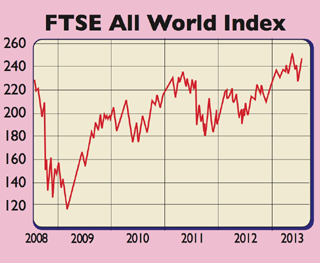
The bulls are back. Last week saw America’s S&P 500 index reach a new record. It is up by almost 20% this year. Global equities, as measured by the FTSE All World index, have also hit a post-crisis peak. A key sign of confidence, notes Jason Abruzzese in the Financial Times, is that defensive stocks are no longer spearheading the rally. In recent weeks, cyclical sectors, such as financials and industrials, have posted the biggest gains.
It’s hard to share investors’ enthusiasm. US data has improved but remain patchy. Elsewhere it’s even less convincing. “Take the Western economies off the angel dust of money printing and super-low interest rates, and the current ‘recovery’ would disappear in a flash,” says Jim Armitage in The Independent. Emerging markets are also slowing.
Note too, says Buttonwood in The Economist, that 52% of fund managers, according to a Bank of America Merrill Lynch global survey, expect global growth to accelerate. Yet economists’ forecasts are being revised down. So investors look complacent about world growth. With growth easing, we can’t count on profits to provide much momentum, not even in America, where S&P profits have hit record highs thanks to unusually wide margins. These are now far more likely to narrow than widen further, as margins tend to revert to the mean.
And sales growth has been nothing to write home about. The earnings picture outside the financial sector is “very weak”, says Sheraz Mian of Zacks.com. It hardly appears to justify further rapid stock-market gains. Then there’s the euro crisis, which policymakers hope can be put on ice until after the September elections in Germany. But given the political upheaval and fragile coalitions in the south, “there is plenty of scope for nasty surprises in the meantime”, says Buttonwood.
Still, investors aren’t in the mood to worry about shaky fundamentals. They’re concentrating on the money-printing continuing. US Federal Reserve chairman Ben Bernanke “is going all out to persuade us that actual monetary tightening is a long way off” and that he will take his foot off the accelerator very slowly, says Chris Iggo of Axa Investment Managers. Hence the “risk-on” mentality. You’d think investors would know by now that liquidity alone doesn’t make a sustainable bull market.
Is the post-2000 bear finally over?
Has the post-2000 bear run in developed markets ended yet? Market history in America, which tends to set the tone for world markets, shows that stocks move in long cycles, from very high valuations to very low ones and back. The high-to-low movement is known as a secular, or long-term, bear market. The opposite is a secular bull market. In secular bears, stocks can fall or move broadly sideways as earnings gradually catch up with valuations. The longest bear on record lasted 20 years.
US valuations, as measured by the cyclically adjusted price-to-earnings ratio (Cape), peaked in 2000 and are still above the historical average. The economic backdrop also suggests we’re still in trouble. The credit bubble burst five years ago following the dotcom bust, but we’ve barely worked off any debt or made a lasting recovery. By contrast, the 1982-2000 bull was marked by the defeat of inflation and falling world interest rates.
Since the bounce in 2009, markets have trended sideways: rising when more liquidity seemed nigh, but capped by the slow recovery amid historically high debt loads, or by fears of tighter money. Until we shake off the credit bubble hangover, the new secular bull is unlikely to begin. That’s not to say stocks are a write-off or that the pattern is identical across the developed world. Japan has been in a secular bear since 1989. Some continental markets have reached single-digit Capes that presage appealing long-term returns. But the roaring 1980s and 1990s are unlikely to return soon.